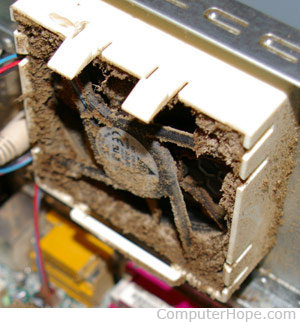Top 10 new computer user tips
Being a new computer user can be nerve-racking, as there are many things to learn about computers and how to use them. Below are Computer Hope's top 10 tips to help new computer users feel more comfortable about using their computer.
Backup important data

A computer or its hard drive can fail at any time and without warning. When it does, all your documents, letters, pictures, music, and videos are lost or may cost money to be recovered. Make sure you have backups of all your important data in case your computer fails.
Protect the computer
Make sure to protect your computer from electrical surges, brownouts, and blackouts. At the very least, every computer user should have a decent surge protector on their computer and phone line if they use a modem. Surge protectors help protect your computer during an electrical storm and could save you hundreds of dollars in repair costs if it were to get damaged. Also, having computers on a UPS (uninterruptible power supply) prevents damage to a computer during a brownout or blackout.
Keep computer and its programs updated

There is no such thing as a perfect software or hardware drivers. After the developer has released their program, they may discover errors and release updates to fix these problems. In the case of major programs and operating systems, there can be several hundred updates and service packs released during its lifetime. Making sure your computer and its programs are up-to-date helps prevent problems.
Also, programs with plugins may need updates, for example, keeping your browser plugins up-to-date is important.
Keep the safe from viruses, spyware, phishing, and spam

Every computer connected to the Internet or other networks need to be protected from viruses. If you are using Microsoft Windows, we recommend having some form of antivirus program installed and running on the computer. It's also a good idea to have a malware detection program to pickup any spyware or malware that an antivirus may not detect. Finally, every computer user should also be fully aware of other security risks such as chain mails, phishing, and spam while on the Internet.
Read, understand, and watch for tricks
One of the most common mistakes a new computer user makes is agreeing to dialog text boxes, agreements, or other prompts without reading the dialog text box or understanding it. Before clicking an OK or install button, make sure you understand what you are doing. If you don't understand the prompt, click the Cancel button or close the box. If there is no way to close the prompt try pressing the Esc.
Also, while installing any program watch for any check boxes. Often free programs, plugins, and updates have check boxes that ask if it's ok to install additional programs onto the computer. For example, when installing the Adobe Flash plugin there may be a check box to install additional antivirus, firewall, toolbar, or other programs. If left checked (often checked by default), these programs are installed and may cause problems or frustration because it is not something you wanted.
Clean the computer clean

Keeping the computer physically clean helps keep the computer running smoothly, help prevent issues such as overheating, and help protect you from getting sick. While cleaning the computer, it is also a good idea to clean the data on the computer. Microsoft Windows users can run ScanDisk to check the hard drive for errors and Defrag to keep the data on the hard drive organized. It is also a good idea to go through the installed programs and uninstall anything you no longer use.
Be familiar with free alternatives
Be familiar with and know about free alternatives to popular commercial programs. For example, almost every computer user needs a word processor program installed on their computer. Instead of purchasing Microsoft Office, which costs several hundred dollars, use a free alternative such as OpenOffice that's as capable.
Take full advantage of all the mouse buttons and wheels

Many new computer users only use the left mouse button. Use the mouse to its full potential by also using the right mouse button to access the context menu. For example, if you highlight text and then right-click that text, it brings up a menu that lets you copy, cut, and perform other functions on that text. Similar functions are available when right-clicking files.
Although most users already use the mouse wheel to scroll up and down, this wheel can also be used as a third-button by pressing down on the wheel. For example, using the wheel as a button, click any link to open that link in a new tab. Some computer mice also allow the wheel to be pushed right-and-left to perform additional features, such as moving forward and back on a web page.
Finally, many computer mice also have side buttons (thumb buttons), that can be programmed to perform an action, such as going back to a previous a web page.
Use included help files and the Internet
Every program has online help that is usually accessed by pressing the F1 while in the program or through the file help menu. If the included help does not answer your questions, searching the Internet using a search engine or using online help services such as Computer Hope can answer those questions.
Become familiar with and use keyboard shortcuts
Every computer user should become familiar with and use keyboard shortcuts. Knowing these shortcuts can drastically increase your productivity on the computer and make your overall computer experience more enjoyable.
